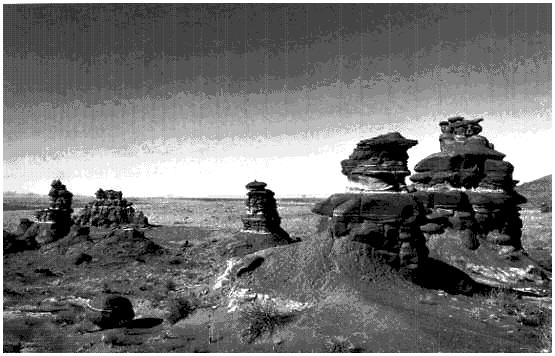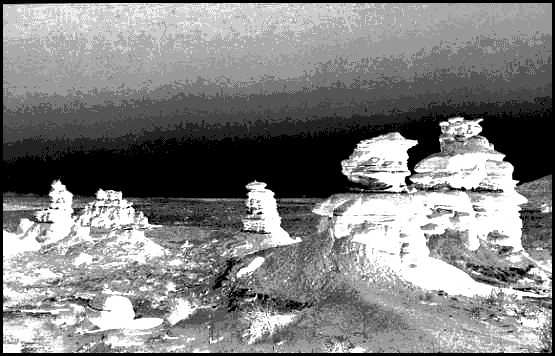
The
Painted
Desert
Land of Wind and Stone
Scott Thybony
David Edwards,
Photographer
(University of Arizona)

According to Thybony, the Navajos have four sacred rivers that encompass the Painted Desert:the Rio Grande to the east, the Little Colorado on the south, the Colorado to the west, and the San Juan on the North.
He also tells us that some have counted "168 distinctive colors and shades." Besides being filled with sand and hoodoos --- the rocks shaped and carved by wind and sand --- it was and still is home to Hopi, Navajos, and Zuni.
There is a ridge called the Aedii Eechii. The author consulted with several people who speak Navajo to find out the meaning of the words. "The three of them tried various pronunciations until the effort left them laughing." One said, "We don't know what it means exactly," but after awhile, they came up with "a pile of excrement that keeps building higher."
Thybony is an anthropologist who is crazy about a place that you and I would not necessarily be too keen about visiting, much less staying there for days on end. There are dust devils, tornadoes, thunderstorms, days that are so hot and wasted that they are guaranteed to fuddle your mind and turn your blood to mud. There are flash floods and slides that come down the arroyo to turn your 4x4 into a gooey mess, not to say what they will do to you.
The Painted Desert is filled with lore. There were dinosaurs who passed through here and were nice enough to leave their footprints behind, over three hundred tracks in various parts of the desert (the tracks are so detailed that one scientist estimated that the beasts were moving nineteen miles-per-hour).
They also kindly left behind stacks of coprolites --- dinosaur turds --- and if you are fond of such doo-dads, they can be bought on-line from a company in Australia, Crystal World, which lists them as "fossilised poo." [See Fig 3 below].
Then there were the scientists that passed through behind the dinosaurs, many who came, in the early years of the twentieth century not only to look at poop, but to steal it (and bones) for private collectors and museums. One was Barnum Brown, named for P. T. Barnum of the circus world. He arrived from the American Museum of Natural History and was such a lady's man that there is a hoodoo named for him: "Brown's Phallus."
There are people, like the author, who come to the desert to explore and charge their batteries. Others --- mostly Navajo --- who eke out a living at the edge of it, serving as volunteer watchdogs. In the not too far past, there were the likes of Barnum Brown and Frank Cushing. He arrived in 1881 to journey down to meet the Havasupai Indians in the depths of the Grand Canyon. Cushing was said to have returned from his journey with an Apache scalp. "Many of his colleagues already thought the pioneer ethnologist had descended into savagery by living with the people he studied ... Their suspicions seemed to be confirmed when word spread of his having taken the enemy scalp, a requirement for initiation into an important warrior society."
The University of Arizona Press has chosen to reprint here fourteen photographs in black-and-white, which might seem to be odd when we are considering a singular desert said to show, in the course of a day, 168 different hues. But these photographs invite the eye to create its own colors, make the volume as impressive as the nine other books put out by the Press in the series "Desert Places."

--- Laurie David